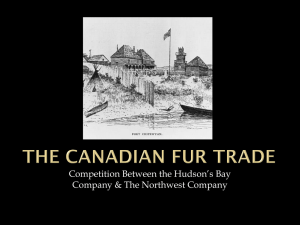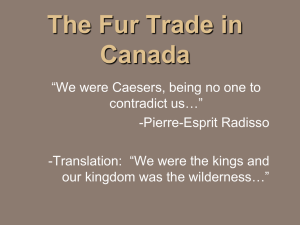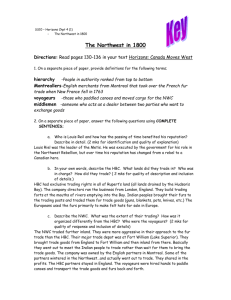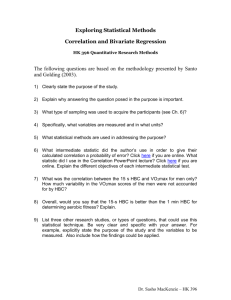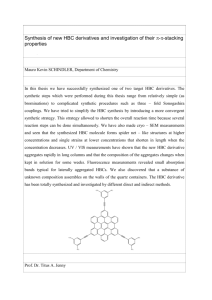File
advertisement
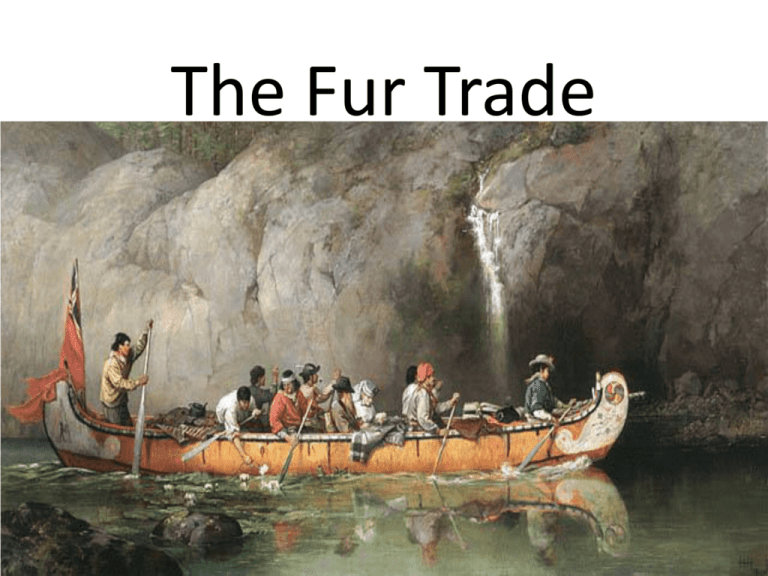
The Fur Trade Unintended Consequences • History is full of unintended consequences. – In 1611, Henry Hudson sought a passage to Asia through the Arctic – He failed, but Europeans became aware of the Hudson Bay which set the stage for a fierce competition within the fur trade that would last more than 100 years and that would involve across the Northwest: • • • • Britain France First Nations Metis – As rival fur traders tried to outdo one another and increase their profits, they explored and mapped the continent The Rise of the HBC • But first a reminder: – In the early 1600s, the French established New France and the British established the 13 Colonies – The Northwest: the vast area to the north and west of Lake Superior – After 1670, the French began to travel west more frequently to find new sources of fur and began building more fur-trade forts – The British also saw the potential of the fur trade and soon both British and French were sending shiploads of beaver pelts back to Europe – The competition between Britain and France, already active in Europe and the colonies, became fierce • Both countries wanted to control North America and its resources The Beginnings of the HBC • In 1654, Medard Chouart Des Groseilliers and his brother-in-law Pierre Esprit Radisson made a trip from Quebec to the interior • The two coureurs de bois set up the first trading post on Lake Superior • While there, Native peoples told them of the vast fur-trading regions to the north and west (around Hudson Bay) • In 1659, after a winter of near starvation Radisson and Groseilliers returned to Montreal • They had thousands of furs with a plan to set up a trading post on Hudson Bay – It would reduce the cost of transporting furs from the Northwest to Europe and they hoped the French king would sponsor their scheme • Quite the opposite happened – Because they had left the colony without permission and were trading without licenses, their furs were confiscated, Groseilliers was put in jail, and they were both fined Radisson and Groseilliers Turn To England • Radisson and Groseilliers next decided to try their idea with the British and in 1665, they presented their plan to the court of King Charles II – He agreed to support their plan • The king's cousin, Prince Rupert of the Rhine, financed the journey • The British acquired two ships, the Nonsuch and the Eaglet and set sail from England in June 1668 • The Eaglet, carrying Radisson, was forced to turn back off the coast of Ireland, but the Nonsuch reached James Bay • After a successful trading expedition over the winter of 1668-1669, the Nonsuch returned to England Monopoly • The expedition was a success and the King granted a charter to Prince Rupert and his partners on May 2, 1670 • In the charter, the "Company of Adventurers of England Trading into Hudson's Bay," better known as the Hudson's Bay Company (HBC), were given a monopoly over the fur trade in all the land whose rivers drained into Hudson Bay – This was a massive geographical area stretching from modern day Quebec in the east, Alberta in the west, and South Dakota to the south • The monopoly also gave the company wide legal and trading powers over the area, as well as complete administrative and judicial control • Rupert Reads Charter to HBC Directors Consider the Following: 1. Imagine you are a member of the French Royal Court at the time of the founding of the Hudson's Bay Company. How might you characterize the role played by Radisson and Groseilliers? 2. How are the French fur traders going to respond to this land grant? The Company of Adventurers • In the seventeenth century, British businesses were expanding around the world and N.A. was seen as a potential source of wealth • HBC policies were set in London • By 1685, trading forts were operating at Rupert River, Moose Factory, Albany Factory, and Port Nelson Baymen • Although the HBC was headquartered in London, the real adventurers of the company were its employees, the Baymen • Most of the early HBC employees were indentured servants – They received food, drink, clothing, lodging, and their transportation to the Hudson Bay – Many Baymen were from the Orkney Islands off the coast of Scotland The Mission of the HBC • As detailed in the HBC charter, the purposes of the company were to be "for the Discovery of a new Passage into the South Sea, and for the finding some Trade for Furs, Minerals, and other considerable Commodities." • In exchange for these duties, the charter granted the Adventurers: the sole Trade and Commerce of all those Seas, Streights, Bays, Rivers, Lakes, Creeks, and Sounds... that lie within the entrance of the Streights commonly called Hudson's Streights, together with all the Lands, Countries and Territories, upon the Coasts and Confines of the Seas, Streights, Bays, Lakes, Rivers, Creeks and Sounds... which are not now actually possessed by any of our Subjects, or by the Subjects of any other Christian Prince or State British vs. French System • The territory of the Hudson's Bay Company's monopoly was enormous, at least in theory (In reality, the HBC controlled only a small area near Hudson Bay) • The British fur-trade system depended on First Nations people bringing furs to the forts along the Bay – as long as the fur supply was steady, the Company saw little need to expand inland • French fur traders were more willing to travel to their First Nations trading partners, bringing the furs back to French posts themselves • Fort Garry Trade with First Nations • First Nations peoples had their own network of trading relationships prior to European contact – The new relationship with the Europeans initially fit into traditional trading patterns • Before long, a protocol developed with the HBC's First Nations trading partners – Annual trading sessions began with the passing of a ceremonial pipe, which was left at the fort to indicate they would return the following year – A ritual exchange of gifts took place – Then the traders began their negotiations Ceremony of the Pipe • Sir George Simpson Receiving a Deputation of Indians in York Factory. Not an image of Fort Churchill but reflective of trade with First Nations The Benefits of Trade • Both Europeans and First Nations people profited during the early years of the trade – First Nations people received new trade goods, such as metal tools – Europeans received furs, and knowledge and technology to help them live and travel in North America European Rivalries • Between 1688 and 1763, Britain and France were frequently at war as they built their Empires • Both countries wanted North America's abundant natural resources for themselves – Business interests in North America and the empire building goals of European countries were intertwined France vs. Britain Part 1 • In the early 1600s, the French dominated the North American fur trade – The St. Lawrence River gave them Atlantic access to the heart of the continent – Montreal prospered as the main fur depot • Between 1640 and 1670, two events directly motivated French expansion into the Northwest French Expansion 1. The Haudenosaunee (Iroquois) Wars. – The Iroquois (allied with the British in the 13 Colonies) defeated the Huron in order to control the supply of fur – Having lost their valuable fur-trade allies the French were forced to seek trading partners farther west 2. The second event that prompted the French to expand west was the creation of the HBC in 1670. – The HBC's impact was felt as early as 1671, when French fur traders noticed less furs reaching Montreal – The French responded with diplomacy toward First Nations and an aggressive military policy to try to eliminate the HBC Consider the Following: • The French and British competed with each other to win over more First Nations trading partners than their rivals 1. What methods do you think they used? 2. What effect do you think this competition had on First Nations? Voyageurs • In 1681, French authorities began giving licenses to coureurs de bois • These licensed traders were known as voyageurs The Battle For the Bay • In the 30 years following the creation of the HBC, the French tried to destroy the HBC forts along the Bay – The First HBC headquarters on the Bay was established at Port Nelson in 1682 – The French quickly responded by sending a naval force to capture and destroy the fort in 1684 • The HBC then relocated and rebuilt the fort on the Hayes River, and called it York Factory Iberville • When war broke out in Europe in 1688, the British and French regularly raided and captured each other's fur-trading posts – Both Moose Factory and Rupert House fell to the French – Pierre Le Moyne d'Iberville, a career soldier and sailor was appointed commander-inchief of Hudson Bay by the French and was sent to capture York Factory • Statue of Pierre LeMoyne d'Iberville, at the Valiantes Memorial, in Ottawa • Sculpture of d'Iberville at the Parliament Building in Quebec The Pelican • In the spring of 1697, the French sent a large fleet to Hudson Bay where the ships became trapped in the ice • Under the command of d'Iberville, the forty-four-gun Pelican broke free and made its way to the mouth of the Hayes River • The French ship was soon surrounded by a British frigate, the Hampshire, and two armed freighters, the Deringand the Hudson's Bay – The British fired the first shot and the Pelican was hit broadside. • The subsequent battle raged for close to 4 hours • In the end, one British ship was sunk, one had surrendered, and the other had retreated. – The Pelican was tattered, but victorious • d’Iberville's French force captured York Factory • Replica of the Pelican which Iberville captured York Factory for the second time The French Win… Wait…For How long? • France had temporarily won the battle for the Bay • Then, in 1713, the British and French signed the Treaty of Utrecht ending the War of Spanish Succession • As part of the agreement, the French gave up all claims to Hudson Bay • Consequently French had to focus their plans for fur-trade expansion on territories in the Northwest Consider the Following: 1. In today’s Canada, who might consider Iberville a hero? 2. Why? France vs. Britain Part 2 • In 1730, New France funded an expedition by Pierre de La Verendrye find a route to the Pacific Ocean as well as to extend the fur trade into the interior of the continent – La Verendrye was the Canadian-born and had served in the French army abroad – Upon returning to Canada, had become a fur trader and farmer. • La Verendrye was given the fur trade monopoly for the areas which he explored • La Vérendrye Monument, La Vérendrye Park The La Verendryes • La Verendrye left Montreal on June 8, 1731, with a group that included three of his sons • He built a series of fur-trading posts that became an important base of French operations in the West – In 1738, La Verendrye established a fort at Fort Rouge (Winnipeg) and Fort La Reine (Portage la Prairie) – From Fort La Reine, La Verendrye travelled through Lake Manitoba, Lake Winnipegosis, Lake Winnipeg, and the Saskatchewan River – He established Fort Dauphin, Fort Bourbon (Grand Rapids), and Fort Paskoya (The Pas) – Two of his sons reached as far west as the Rockies • He also explored North and South Dakota, setting the stage for New France's significant territorial growth Trade Pushes Inland Expansion • La Verendryes established a pattern for Montreal's inland trade and French became strong competition for the British • Instead of waiting at their posts the French sought out First Nations in their own territory which eliminated the considerable work of hauling furs to Hudson Bay • The voyageurs diverted many furs on their way to the Bay by intercepting First Nations traders on their journey north • HBC shareholders in London were furious at the drop in profits and the HBC realized that it needed to move inland in order to compete – In 1743, the HBC built its first inland post at Henley House First Nations Role in the Fur Trade • The fur trade in North America began with the earliest contacts between First Nations people and Europeans • First Nations traders used British-French rivalries to their advantage, frequently demanding better terms • From the beginning, First Nations people eagerly sought European goods • The unit of currency in the fur trade was one "made-beaver," a prime beaver pelt that had been worn until most of the beaver's long outer hair had been worn off Barter Supplies Value of Supplies in Beaver Pelts • • • • • • • • • • 2.25 kg of sugar 1 gun 2 scissors 20 fish hooks 1 pair of shoes 1 beaver pelt 12 beaver pelts 1 beaver pelt 1 beaver pelt 1 beaver pelt Role of First Nations in the HBC • First Nations Peoples acted HBC middlemen until the 1720s – They travelled upstream, especially along the Saskatchewan River, trading for furs with other First Nations – They then transported these furs to the trading posts on Hudson Bay • Many middlemen and their families began to settle near the HBC forts and became what were known as the home guard • Some First Nations people worked for the traders, hunting, paddling supply canoes, and making snowshoes Consider the Following 1. How do you think the cultures of the home guard changed as the people began living in permanent or semi-permanent villages near the HBC forts? The Custom of the Country • Even after the signing of the Treaty of Utrecht the voyageurs continued to travel, trade, and live in the Northwest – They were more at home among First Nations communities than in the villages of New France • Many French traders took First Nations women as wives in a formal process known as the Custom of the Country – First Nations had a tradition of building alliances with other communities through marriages – The fur traders and their masters in Montreal also encouraged these relationships The Metis • French officials believed the marriages would strengthen friendships and trade and assimilate aboriginals • To the surprise and dismay of French authorities many of their French traders began adopting First Nations ways of life instead • In time, a new culture and people arose from these unions: the Metis • Metis children were raised with elements of both French and First Nations cultures and were immersed in the fur trade culture and economy The Metis Nation • Metis children were raised within a blended culture and over time Metis communities began to emerge, especially near the Red River – The Metis culture was born of the French fur trade • Metis people bridged cultural gaps, creating better trading relationships. • They played a special and vital role in the fur trade Country-Born • In contrast, early on the HBC strictly forbade its employees from marrying First Nations women – However, this rule was regularly violated by HBC employees • By the 1740s the HBC acknowledged the limits of its control and eased off its rule • HBC employee families began to settle around HBC forts and became a significant part of the home guard • The children of the Baymen and First Nations women were known as Country-born • Country-born families developed a culture that was distinct from that of the French Metis Consider the Following: • Some Europeans stayed with their First Nations wives only as long as their posting in the Northwest, while others formed lifelong bonds – Many voyageurs, in particular, retired to live with their wife, children, and their wife's extended family • In the early days of the HBC fur trade, First Nations wives occasionally accompanied their husbands to Britain when the men retired from the fur trade, however most husbands returned to Britain alone 1. What does this tell you about the Custom of the Country? First Nations Women’s Role in the Fur Trade • For European fur traders were indispensable • First Nations wives provided companionship, and kinship connections as well as: – – – – – – – – – – – – – – – – Translated, and acted as intermediaries in trade sessions provided food, prepared furs for travel gathered supplies for canoe repairs padded acted as guides raised families made moccasins, netted snowshoes cleaned and tanned pelts snared rabbits and small game collected berries tended gardens Fished dried fish and preserved other food helped make pemmican Kinship Connections • In traditional First Nations societies, relationships were key and until they were established, business could not be done • By marrying into a First Nations community, a fur trader established a kinship relationship with everyone in that community and, by extension, to other communities as well • These kinship relationships opened the door to trading partnerships Pemmican • Pemmican consists of dried bison meat mixed with fat and sometimes berries – It is light to transport and keeps well without spoiling • This food, long a staple in the diet of many First Nations, would eventually become the main food of all fur traders Disease • As fur traders moved west, they carried diseases: – smallpox, influenza, measles, scarlet fever. • First Nations in the east had already been devastated by these diseases, but Western First Nations, were exposed as the fur trade expanded – From 1780 to 1784, a major smallpox epidemic spread throughout First Nations in the West wiping out entire communities Conflict Among First Nations • As it had near the eastern Great Lakes, the uneven distribution of firearms among First Nations resulted in deadly conflicts between communities – Communities with guns had a major military advantage The Fur Trade without France • When the French surrendered in 1760 the HBC believed the fall of New France would mean the end of French competition for the fur trade • They expected that the golden age of their fur trade monopoly would begin – This expectation, however, did not come to pass Vacuum • After the fall of New France, the northwestern fur trade became, in many ways, a free-for-all as entrepreneurial English, Scottish and Yankee traders rushed to Montreal to take over the profitable French trade routes – They ignored the HBC charter and many voyageurs continued in the fur trade, selling their furs to English, Scottish, or Yankee traders • They formed several small companies that fought to dominate the Montreal trade The Competition Heats Up • The Montreal based approach to the fur trade was highly successful – In 1773, York Factory (HBC) received 8000 beaver, down from 30 000 the decade before – This drop in furs reaching the Bay prompted the HBC to take action, pushing inland expansion The North West Company • By the 1770s, the Montreal-based fur trade extended as far northwest west as Lake Athabasca- 4800 km from Montreal – Transportation expenses were mounting and the major Montreal operators began working together to save costs • In 1779, several of these operators formed the North West Company (NWC) – The NWC was led by several businessmen of varying backgrounds including Simon McTavish – Among the other shareholders were Alexander Mackenzie, Simon Fraser, and Peter Pond, all fur traders and three of Canada's best-known explorers NWC vs. HBC • The NWC had 23 partners, but more than 2000 guides, interpreters, and voyageurs • McTavish and other Scots shareholders married French Canadian women and French Canadians played key roles in the company • The company's blend of Scottish and French cultures kept it distinct from the more conservative, cautious HBC • The NWC became known for its bold and aggressive approach to business – The company motto was “perseverance” The Pattern of Expansion • The NWC refused to recognize the HBC monopoly in Rupert’s Land and the HBC had no way to enforce it • The Nor'Westers- as the NWC traders came to be known- continued the French pattern of travelling to First Nations to trade with them, and the HBC was forced to adopt similar methods – Both companies expanded their operations farther and farther west to keep ahead of the other – They built fur trading posts next door to each other The NWC’s Competitive Advantage • The North West Company dominated the fur trade until it merged with the HBC in 1821 • The NWC had several competitive advantages – The NWC was owned and operated by men who were themselves active in the business – The NWC also had the benefit of its skilled and experienced voyageurs The HBC Model • In contrast, the HBC's directors and investors were primarily English noblemen and financiers who governed the company from London – Their interest in the business was overwhelmingly financial – Few had much knowledge of the lands and people from which their furs came So….Who Won? • As we will see later, this rivalry became increasingly bitter, fierce, and violent • By the early 1800s the companies were essentially at war (literally) with one another • However, oddly enough, the 2 companies merged in 1821 • Why? – The NWC could not sustain the rising costs of pushing further and further west in search of furs – They were broke and had no choice • More to come later….
